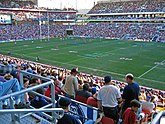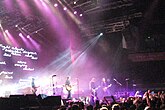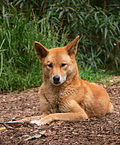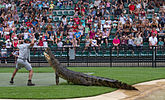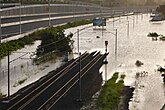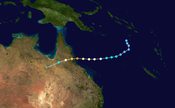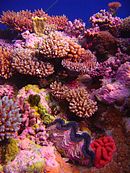Portal:Queensland/Selected article
Usage
[edit]The layout design for these subpages is at Portal:Queensland/Selected article/Layout.
- Add a new selected article to the next available subpage.
- Update "max=" to new total for its {{Random portal component}} on the main page.
Selected articles list
[edit]Portal:Queensland/Selected article/1
Powderfinger is an alternative rock band based in Australia. The band formed in Brisbane, Australia, in 1989, and their lineup since 1992 has consisted of vocalist Bernard Fanning, guitarists Darren Middleton and Ian Haug, bassist John Collins, and drummer Jon Coghill.
Powderfinger became a commercial success with their third studio album Internationalist in 1998. Since then, they have released several hit singles and award-winning works; earning them a total of fifteen ARIA Awards. Numerous Powderfinger albums have reached platinum status multiple times, and rankings in the top 100 of Australian music charts. Odyssey Number Five, Powderfinger's most successful to date, earned over eight platinum certifications and ARIA Awards in five different categories.
Portal:Queensland/Selected article/2
The Great Barrier Reef is the world's largest coral reef system, composed of roughly 3,000 individual reefs and 900 islands stretching for 2,600 kilometres (1,616 mi) over an area of approximately 344,400 square kilometres (133,000 sq mi). The reef is located in the Coral Sea, off the coast of Queensland in northeast Australia.
The Great Barrier Reef can be seen from outer space and is the world's biggest single structure made by living organisms. This reef structure is composed of and built by billions of tiny organisms, known as coral polyps. The Great Barrier Reef supports a wide diversity of life, and was selected as a World Heritage Site in 1981. CNN has labelled it one of the seven natural wonders of the world, and the Queensland National Trust has named it a state icon of Queensland. A large part of the reef is protected by the Great Barrier Reef Marine Park, which helps to limit the impact of human use, such as overfishing and tourism
Portal:Queensland/Selected article/3
Palm Island, also known by the Aboriginal name Bukaman, is a tropical island with a resident community of about 2,000 people. The settlement is named variously Palm Island, the Mission, Palm Island Settlement or Palm Community. The island is situated 65 kilometres north-west of Townsville, on the east coast of Queensland, Australia 800 kilometres north of the Tropic of Capricorn. It is the main island of the Greater Palm group, and consists of small bays, sandy beaches and steep forested mountains rising to a peak of 548 metres. Neighbouring islands outside the Palm group include Rattlesnake Island and Magnetic Island.
Palm Island is often termed a classic "tropical paradise" given its natural endowments, but it has had a troubled history since the European settlement of Australia. For much of the twentieth century it was used by the Queensland Government as a settlement for Aboriginals considered guilty of such infractions as being "disruptive", being pregnant to a white man or being born with "mixed blood".
Portal:Queensland/Selected article/4
The 1992 Queensland storms were a series of thunderstorms which struck southeastern Queensland, Australia on November 29, 1992. The storms produced strong winds, flash flooding and large hailstones in the region, including the capital city of Brisbane. The storms also spawned two of the most powerful tornadoes recorded in Australia, including the only Australian tornado to be given an 'F4' classification on the Fujita scale.
The meteorological instability in the region resulted in the formation of at least five supercell thunderstorms in the space of around three hours. The storms, which spawned progressively further up the coast from Brisbane to Gladstone as the afternoon progressed, left a trail of damage resulting from hail, rain and wind. The event has been described as "one of the most widespread [outbreaks of severe thunderstorms] recorded" by veteran meteorologist Richard Whitaker.
Portal:Queensland/Selected article/5
Bill Brown (born July 31, 1912) is a former Australian Test cricketer who played 22 Tests between 1934 and 1948. Brown captained Australia in one Test in March 1946, against New Zealand in a match retrospectively awarded Test status. A right-handed opening batsman who along with Jack Fingleton formed an opening pair in the 1930s regarded as one of the finest in Test history, Brown was a member of Don Bradman's Invincibles that toured England in 1948 without suffering a defeat.
Due to the presence of Arthur Morris and Sid Barnes as the preferred openers, Brown only played in two of the five Tests, batting out of position in the middle order. Brown was also notable for being the player to be "Mankaded" – In a match in 1947–48, Brown had backed up too far and left his crease before the bowler, India's Vinoo Mankad delivered the ball. Mankad promptly removed the bails with Brown out of his ground.
Portal:Queensland/Selected article/6
The Brisbane Broncos are an Australian professional rugby league club based in the city of Brisbane. The Broncos play in Australasia's elite competition, the National Rugby League premiership. The Broncos have won six premierships during their twenty years in competition, making them the league's most successful club.
The club was founded in 1988 as part of the New South Wales Rugby League premiership's national expansion, becoming, along with the Gold Coast-Tweed Giants, one of Queensland's first two participants in the Winfield Cup. The Broncos later played a significant role in the Super League war of the mid-1990s before continuing to compete successfully in the reunified National Rugby League competition of today.
Portal:Queensland/Selected article/7
Karmichael Hunt (born 17 November 1986 in Auckland, New Zealand) is a professional rugby league footballer for the Brisbane Broncos in the Australian National Rugby League competition. Hunt primarily plays in the fullback position, but he also played on the wing and at halfback. Hunt has played first-grade rugby league for Brisbane since 2004, and was part of the Broncos' competition-winning team in 2006.
Hunt made his NRL debut in 2004 and played every game that season, winning the Dally M Rookie of the Year award. In a controversial move, Hunt chose to play for Australia instead of his native New Zealand, citing a lifelong dream of playing for Queensland in State of Origin. He has represented the Queensland Maroons in the interstate State of Origin series and the Australian Kangaroos at international level.
Portal:Queensland/Selected article/8
The discography of Powderfinger, an Australian rock group, includes released six studio albums, twenty-three singles and four extended plays, two live albums, one "best of" album and three video releases. Shortly after the independent release of their debut self-titled EP in 1993, Powderfinger signed on to a major record label to release their second EP, Transfusion, and in 1994, they released their debut album Parables for Wooden Ears. After performances at music festivals and appearances on several compilation albums, Powderfinger released their second studio album, Double Allergic (1996).
Following public recognition from the album's high-selling singles, Powderfinger went on to release Internationalist in 1998, which sold over 280,000 copies, and reached platinum status five times. In September 2000, Powderfinger released their fourth album, Odyssey Number Five, which has sold over 350,000 copies. Two of the album's songs, "These Days" and "My Kinda Scene" were released on the soundtracks for Two Hands (1999), and Mission: Impossible 2 (2000).
Portal:Queensland/Selected article/9
The dingo is a type of wild dog, probably descended from the Southern-East Asian Wolf. It is commonly described as an Australian wild dog, but is not restricted to Australia, nor did it originate there. Modern dingoes are found throughout Southeast Asia, mostly in small pockets of remaining natural forest, and in mainland Australia, particularly in the north. They have features in common with both wolves and modern dogs, and are regarded as more or less unchanged descendants of an early ancestor of modern dogs. The name dingo comes from the language of the Eora Aboriginal people, who were the original inhabitants of the Sydney area.
Dingoes have received bad publicity in recent years as a result of the highly publicised Azaria Chamberlain disappearance and also because of dingo attacks on Fraser Island in Queensland. In 2001 around 200 dingoes lived on the island, and 20 people were attacked in the preceding six years. In April 2001 a nine-year-old child was killed in one such attack near Waddy Point on Fraser Island. This led to a cull of the animals which were actually protected by law.
Portal:Queensland/Selected article/10
Small Mercies is an alternative rock band from Brisbane, Australia. The band formed in 1997 (see 1997 in music), and its current lineup is Steve Blaik, Danny Procopis, Marty O'Brien, and Jeff Reeves. Small Mercies have released two EPs (Is This Life? and Off The Record), and are soon to release their first studio album, Beautiful Hum. "Innocent", a song from Beautiful Hum, was nominated for the 2007 ARIA Award for Breakthrough Artist - Single, the band's first and only award nomination.
Small Mercies was first established when the band members were teenagers since Blaik, Procopis and O'Brien all attended high school together. The band also contained Simon O'Connor (guitar) and Shaun Spooner (bass guitar, vocals). In 2001, they made it to the finals of the Brisbane Rock Award (under the name "Seventh Avenue"), earning them the rights to play at Queen Street Mall Basement. This performance attracted the attention of Shawthing Entertainment, as well as industry veterans including John Woodruff.
Portal:Queensland/Selected article/11
The players of Queensland Roar FC compete in the A-League, the premier domestic football (soccer) competition in Australia. It was founded in 2004, and the Queensland Roar were one of the eight inaugural clubs to participate in the new competition. The A-League competition consists of a regular season and a finals series of the top four teams, with the premiership being awarded to the club who finishes on top of the table in the regular season, and the championship to the winner of the Grand Final.
The Roar have missed the finals in both of the A-League seasons to date, finishing sixth in 2005–06 and fifth in 2006–07 on goal difference to Sydney FC, who finished fourth. Queensland have had four players compete for them who have been capped at international level - three for Australia and one for China. This includes the current record-holder for goals for the Australian national team, Damian Mori, who is the current equal-leading goalscorer for the Roar.
Portal:Queensland/Selected article/12
Brisbane is the third largest city in Australia, as well as the capital and most populous city of the Australian state of Queensland. It is set close to the Pacific Ocean, and is situated on the Brisbane River on plains between Moreton Bay and the Great Dividing Range in south-eastern Queensland.
The city is named in honour of Sir Thomas Brisbane who was Governor of New South Wales from 1821 – 1825. The original settlement grew from a harsh penal colony established at his direction in 1824 at Redcliffe, 28 km (17.4 mi) to the north. The colony was moved to what is now the location of the Brisbane CBD in 1825, and free settlers were permitted from 1842. It was chosen as the capital when Queensland was proclaimed a separate colony, in 1859. The city developed slowly until after World War II, when it played a central role in the Allied campaign as the South West Pacific headquarters for General Douglas MacArthur.
Portal:Queensland/Selected article/13
Moreton Bay is a bay on the eastern coast of Australia 45 km from Brisbane, Queensland. The bay extends some 125 km from Caloundra in the north almost to Surfers Paradise in the south. The bay's southern navigation entrance is the Gold Coast Seaway and it is 35 km across at its widest point. It is separated from the Pacific Ocean by a chain of three sand islands - Moreton Island in the north, North Stradbroke Island, and South Stradbroke Island in the south. Tipplers Passage is the main channel on the western coast of South Stradbroke Island. The Gold Coast Seaway is at the southern extent of Moreton Bay, before the Gold Coast Broadwater.
It is one of Queensland's most important coastal resources. The waters of Moreton Bay are a popular destination for recreational anglers and are used by commercial operators who provide seafood to market. The Port of Brisbane coordinates large traffic along the shipping channel which crosses the northern section of the bay. The bay serves as a safe approach to the airport and reduces noise pollution over the city to the west of the runway. A number of barge, ferry and water-taxi services also travel over the bay. Moreton Bay has been the site of conflict between indigenous Australians and early European settlers. It contains environmentally significant habitats and large areas of sandbanks. Many parts of the mainland foreshore and southern islands are settled.
Portal:Queensland/Selected article/14
Fraser Island is an island located along the southern coast of Queensland, Australia, approximately 200 kilometres (120 mi) north of Brisbane. Its length is about 120 kilometres (75 mi) and its width is approximately 24 kilometres (15 mi). It was inscribed as a World Heritage site in 1992. The island is considered to be the largest sand island in the world at 1840 km². It is also Queensland's largest island, Australia's sixth largest island and the largest island on the East Coast of Australia.
The island has rain forests, eucalyptus woodland, mangrove forests, wallum swamps, sand dunes and coastal heaths. It is made up of sand that has been accumulating for approximately 750,000 years on volcanic bedrock that provides a natural catchment for the sediment which is carried on a strong offshore current northwards along the coast. Unlike many sand dunes, plant life is abundant due to the naturally occurring mycorrhizal fungi present in the sand, which release nutrients in a form that can be absorbed by the plants. Fraser Island is home to a small number of mammal species, as well as a diverse range of birds, reptiles and amphibians, including the occasional saltwater crocodile. The island is part of the Fraser Coast Regional Council and protected in the Great Sandy National Park.
Fraser Island has been inhabited by humans for as much as 5,000 years. Explorer James Cook sailed by the island in May of 1770. Matthew Flinders landed near the most northern point of the island in 1802. For a short period the island was known as Great Sandy Island. The island became known as Fraser due to the stories of a shipwreck survivor named Eliza Fraser. Today the island is a popular tourism destination.
Portal:Queensland/Selected article/15
Australia Zoo is a 76-acre (31 ha) zoo located on the Sunshine Coast near Beerwah and the Glass House Mountains. It is a member of the Zoo and Aquarium Association (ZAA) and is owned by Terri Irwin, the widow of Steve Irwin, whose wildlife documentary series The Crocodile Hunter made the zoo a popular tourist attraction. The zoo is managed by Director Wes Mannion
Australia Zoo was opened by Bob and Lyn Irwin on June 3rd 1970 under the name Beerwah Reptile Park. Their son Steve, had helped his parents since childhood to care for crocodiles and reptiles and to maintain the growing number of animals in the zoo. In 1982 the park was renamed to the Queensland Reptile and Fauna Park and the area was doubled with the purchase of another 4 acres (1.6 ha). Steve and Terri changed the name of their now growing wildlife park to Australia Zoo. As filming generated extra funds, Steve and Terri put all money raised from filming and merchandise into conservation and building new exhibits.
Australia Zoo won the Australian Tourism Awards for 2003-2004 in the category Major Tourist Attraction. In 2004, the Australian Animal Hospital was opened next to the zoo to help with animal care and rehabilitation. As well as viewing a wide ranges of birds, mammals and reptiles visitors can view a crocodile feeding and participate in an elephant feeding.
Portal:Queensland/Selected article/16
Qantas was founded in Winton, Queensland on 16 November 1920 as Queensland and Northern Territory Aerial Services Limited by Paul McGuiness, Hudson Fysh, Fergus McMaster and Arthur Baird. Initially the airline operated air mail services subsidised by the Australian government, linking railheads in western Queensland. Between 1926 and 1928 Qantas built several aircraft in Longreach and made the inaugural flight of the Royal Flying Doctor Service of Australia, departing from Cloncurry. Qantas Empire Airways Limited (QEA) was formed by Qantas and Britain's Imperial Airways in 1934. They flew internationally from May 1935, when the service from Darwin was extended to Singapore. As operations expanded with flying boat service World War disrupted air travel until 1943. In 1947, QEA was nationalised, with the Australian Labor government buying the shares. In the same year the airline took delivery of Lockheed 749 Constellations and these took over the trunk route to London. In 1958, Qantas became the second round-the-world airline, flying Super Constellations westward from Australia to London through Asia and the Middle East.
In 1956, Qantas ordered the Boeing 707-138 jet airliner and the first was delivered in June 1959. The first jet service operated by Qantas was on 29 July 1959 from Sydney to San Francisco via Nadi and Honolulu. On 5 September 1959 Qantas became the third airline to fly jets across the North Atlantic. In 1966, the airline diversified its business by opening the 450 room Wentworth Hotel in Sydney. In 1967, the airline placed orders for the Boeing 747 and Qantas Empire Airways changed its name to Qantas Airways. When Cyclone Tracy devastated the town of Darwin at Christmas 1974, Qantas established a world record for the most people ever embarked on a single aircraft when it evacuated 673 people on a single Boeing 747 flight. In March 1979, Qantas operated its final Boeing 707 flight from Auckland to Sydney, and became the only airline in the world to have a fleet that consisted of Boeing 747s only.
Portal:Queensland/Selected article/17
The 2010–2011 Queensland floods were a series of floods hit Australia, beginning in December 2010, primarily in the state of Queensland including its capital city, Brisbane. The floods forced the evacuation of thousands of people from towns and cities. At least 70 towns and over 200,000 people were affected. Damage initially was estimated at around A$1 billion. The estimated reduction in Australia's GDP is about A$30 billion.
Three-quarters of the state of Queensland was declared a disaster zone. The 2010–2011 floods killed 35 people in Queensland. As of 26 January, an additional nine persons are missing. The Queensland floods were followed by the 2011 Victorian floods which saw more than 50 communities in western and central Victoria also grapple with significant flooding.
Portal:Queensland/Selected article/18
Cape York Peninsula is a large remote peninsula located in Far North Queensland at the tip of the state of Queensland, Australia, the largest unspoilt wilderness in eastern Australia and one of the last remaining wilderness areas on Earth. Although the land is mostly flat and about half of the area is used for grazing cattle, and wildlife is threatened by introduced species and weeds, the relatively undisturbed eucalyptus wooded savannahs, tropical rainforests and other types of habitat are now recognized for their global environmental significance.
The west coast borders the Gulf of Carpentaria and the east coast borders the Coral Sea. At the peninsula’s widest point, it is 430 km from the Bloomfield River, in the southeast, across to the west coast (just south of the Aboriginal community of Kowanyama). It is some 660 km from the southern border of Cook Shire, to the tip of Cape York. At the tip of the peninsula lies Cape York, the northernmost point on the Australian continent. It was named by Lieutenant James Cook on 21 August 1770 in honor of Prince Edward, Duke of York and Albany, a brother of King George III of the United Kingdom
Portal:Queensland/Selected article/19
Severe Tropical Cyclone Larry (RSMC Nadi designation: 15F, JTWC designation: 17P) was a tropical cyclone that made landfall in Australia during the 2005-06 Southern Hemisphere tropical cyclone season. Larry originated as a low pressure system over the eastern Coral Sea on 16 March and was monitored by the Australian Bureau of Meteorology in Brisbane, Australia. The low-pressure area formed into a tropical cyclone two days later and quickly strengthened into a Category 5 storm on the Australian tropical cyclone scale. Larry made landfall in Far North Queensland close to Innisfail on 20 March as a Category 4 with wind gusts reaching 240 kilometres per hour (150 mph) and dissipated over land soon after. Cyclone Larry caused nearly A$1 billion in damage, and one fatality.
Portal:Queensland/Selected article/20
The Coral Sea is a marginal sea off the northeast coast of Australia. It is bounded in the west by the east coast of Queensland, thereby including the Great Barrier Reef, in the east by Vanuatu (formerly the New Hebrides) and by New Caledonia, and in the north approximately by the southern extremity of the Solomon Islands. It merges with the Tasman Sea in the south, with the Solomon Sea in the north and with the Pacific Ocean in the east. On the west, it connects with the Arafura Sea through the Torres Strait.
The sea is characterised by its warm and stable climate, with frequent rains and tropical cyclones. It contains numerous islands and reefs, as well as the world's largest reef system, the Great Barrier Reef (GBR), which was declared a World Heritage Site by UNESCO in 1981. All previous oil exploration projects were terminated at the GBR in 1975, and fishing is restricted in many areas. The reefs and islands of the Coral Sea are particularly rich in birds and aquatic life and are a popular tourist destination, both nationally and internationally.





